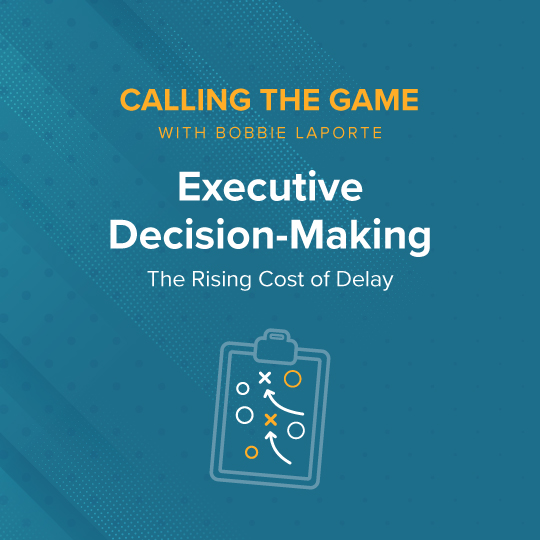Decision-making is different now—and the cost of delay is greater than ever before. That can be a frightening prospect, but as a leader it’s important to understand and adapt. Watch Bobbie LaPorte’s July 23 “Calling the Game” video for some practical tips you can use the next time you have a critical decision to make.
Pushing Boundaries in High-Stakes Leadership: Reframing the True Cost of Comfortable, Cautious, and Autopilot
In a recent post, I covered how to deal with different approaches to decision-making. While this is a natural part of company life, I believe leaders will need to develop specific expertise in this area, given our uncertain and constantly changing environment.
Here’s why.
There’s no question that decision-making is different now. Timelines have forever changed; leaders must now face the reality of needing to make split-second decisions when there is no clear path forward. With the pace at which things are changing in our world, we need to recognize that the cost of delay is much greater now than it was before.
This can be a frightening and anxious place from which to operate. During times of volatility, many leaders default to inactivity, to an overly cautious approach. Their instinct is to hold back, to wait for the horizon to clear, to tell themselves that this is not that different from situations they have experienced before.
But they are fooling themselves if they think that way.
Here’s a scenario familiar to many leaders.
You’ve learned that there are organizational changes coming in your company. Often, this means a new structure, shifting priorities, different ways of operating, and new expectations. You are expected to continue to make decisions and to provide guidance and direction to your team. How do you do that when you literally don’t know which end is up?
My Guidance on Executive Decision-Making
Start by creating a reasonable expectation in your own mind about what you need to decide and when. That includes making the day-to-day executive decisions that keep your team grounded and moving forward. Your approach must move beyond both being stuck (and hoping no one will notice) and leaping toward something that feels easy, known, and comfortable (and hoping it sticks).
This requires the discipline to get off autopilot—to stop and think about what you are facing and not automatically respond based on what you think you know.
It’s tough for leaders to face that they really don’t know what to do, and that’s okay. You need to develop the ability to confidently evaluate alternatives in the heat of the moment, recognizing that you may be headed down a path we have never been before.
Consider a decision you made recently. Was it made on autopilot, or did it push the boundaries of your comfort zone?
In my next post we will talk about another aspect of this – no longer making minimizing risk the primary focus in decision-making.
Related Posts
Decision-Making is Different Now →
Don’t Hit the “Pause” Button on Executive Decision-Making →
How Can I Improve My Decision-Making Under Uncertainty? →
Leadership Shift #1: A New Model for Decision-Making →
Decision Dynamics: 3 Shifts Leaders Must Make Now – Part 2 →
How to Make Decisions in Uncharted Territory →
Navigating Decision-Making Differences in Executive Leadership →


